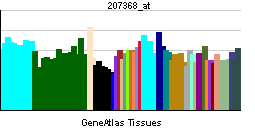5-HT1D receptor
| 5-hydroxytryptamine (serotonin) receptor 1D | |||||||||||
|---|---|---|---|---|---|---|---|---|---|---|---|
| Identifiers | |||||||||||
| Symbols | HTR1D ; 5-HT1D; HT1DA; HTR1DA; HTRL; RDC4 | ||||||||||
| External IDs | Template:OMIM5 Template:MGI HomoloGene: 20240 | ||||||||||
| |||||||||||
| RNA expression pattern | |||||||||||
 | |||||||||||
| More reference expression data | |||||||||||
| Orthologs | |||||||||||
| Template:GNF Ortholog box | |||||||||||
| Species | Human | Mouse | |||||||||
| Entrez | n/a | n/a | |||||||||
| Ensembl | n/a | n/a | |||||||||
| UniProt | n/a | n/a | |||||||||
| RefSeq (mRNA) | n/a | n/a | |||||||||
| RefSeq (protein) | n/a | n/a | |||||||||
| Location (UCSC) | n/a | n/a | |||||||||
| PubMed search | n/a | n/a | |||||||||
5-hydroxytryptamine (serotonin) receptor 1D, also known as HTR1D, is a 5-HT receptor, but also denotes the human gene encoding it.[1]
| Agonists | Antagonists |
|---|---|
|
5-HT1D acts on the CNS, and affects locomotion and anxiety. It also induces vascular vasoconstriction in the brain. Ergotamine works primarily through the 5-HT1B receptor, since the effect through the 5-HT1D receptor is contrary to the mode of action of ergotamine, i.e. vasoconstriction.
See also
References
- ↑ "Entrez Gene: HTR1D 5-hydroxytryptamine (serotonin) receptor 1D".
- ↑ Glennon RA, Hong SS, Dukat M, Teitler M, Davis K (1994). "5-(Nonyloxy)tryptamine: a novel high-affinity 5-HT1D beta serotonin receptor agonist". J. Med. Chem. 37 (18): 2828–30. doi:10.1021/jm00044a001. PMID 8071931.
Further reading
- Hamblin MW, Metcalf MA, McGuffin RW, Karpells S (1992). "Molecular cloning and functional characterization of a human 5-HT1B serotonin receptor: a homologue of the rat 5-HT1B receptor with 5-HT1D-like pharmacological specificity". Biochem. Biophys. Res. Commun. 184 (2): 752–9. PMID 1315531.
- Weinshank RL, Zgombick JM, Macchi MJ; et al. (1992). "Human serotonin 1D receptor is encoded by a subfamily of two distinct genes: 5-HT1D alpha and 5-HT1D beta". Proc. Natl. Acad. Sci. U.S.A. 89 (8): 3630–4. PMID 1565658.
- Hamblin MW, Metcalf MA (1991). "Primary structure and functional characterization of a human 5-HT1D-type serotonin receptor". Mol. Pharmacol. 40 (2): 143–8. PMID 1652050.
- Libert F, Passage E, Parmentier M; et al. (1992). "Chromosomal mapping of A1 and A2 adenosine receptors, VIP receptor, and a new subtype of serotonin receptor". Genomics. 11 (1): 225–7. PMID 1662665.
- Libert F, Parmentier M, Lefort A; et al. (1989). "Selective amplification and cloning of four new members of the G protein-coupled receptor family". Science. 244 (4904): 569–72. PMID 2541503.
- Cargill M, Altshuler D, Ireland J; et al. (1999). "Characterization of single-nucleotide polymorphisms in coding regions of human genes". Nat. Genet. 22 (3): 231–8. doi:10.1038/10290. PMID 10391209.
- Salim K, Fenton T, Bacha J; et al. (2002). "Oligomerization of G-protein-coupled receptors shown by selective co-immunoprecipitation". J. Biol. Chem. 277 (18): 15482–5. doi:10.1074/jbc.M201539200. PMID 11854302.
- Strausberg RL, Feingold EA, Grouse LH; et al. (2003). "Generation and initial analysis of more than 15,000 full-length human and mouse cDNA sequences". Proc. Natl. Acad. Sci. U.S.A. 99 (26): 16899–903. doi:10.1073/pnas.242603899. PMID 12477932.
- Bergen AW, van den Bree MB, Yeager M; et al. (2004). "Candidate genes for anorexia nervosa in the 1p33-36 linkage region: serotonin 1D and delta opioid receptor loci exhibit significant association to anorexia nervosa". Mol. Psychiatry. 8 (4): 397–406. doi:10.1038/sj.mp.4001318. PMID 12740597.
- Gerhard DS, Wagner L, Feingold EA; et al. (2004). "The status, quality, and expansion of the NIH full-length cDNA project: the Mammalian Gene Collection (MGC)". Genome Res. 14 (10B): 2121–7. doi:10.1101/gr.2596504. PMID 15489334.
- Rual JF, Venkatesan K, Hao T; et al. (2005). "Towards a proteome-scale map of the human protein-protein interaction network". Nature. 437 (7062): 1173–8. doi:10.1038/nature04209. PMID 16189514.
- Gregory SG, Barlow KF, McLay KE; et al. (2006). "The DNA sequence and biological annotation of human chromosome 1". Nature. 441 (7091): 315–21. doi:10.1038/nature04727. PMID 16710414.
- Li J, Zhang X, Wang Y; et al. (2007). "The serotonin 5-HT1D receptor gene and attention-deficit hyperactivity disorder in Chinese Han subjects". Am. J. Med. Genet. B Neuropsychiatr. Genet. 141 (8): 874–6. doi:10.1002/ajmg.b.30364. PMID 17099886.
This article incorporates text from the United States National Library of Medicine, which is in the public domain.
| Stub icon | This membrane protein–related article is a stub. You can help Wikipedia by expanding it. |